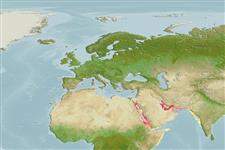Environment: milieu / climate zone / गहराई सीमा / distribution range
पारिस्थितिकी
समुद्री प्रवाल-भित्ति संयुक्त; गहराई सीमा ? - 10 m (Ref. 100374). Tropical
Western Indian Ocean: Red Sea and the Gulf of Aden.
आकार / वज़न / Age
परिपक्व अवधि: Lm ? range ? - ? cm
Max length : 14.0 cm TL पुल्लिंग / अलिंग; (Ref. 9710)
Inhabits rocky and coral reefs. Hides behind big non-predatory fishes to get to its prey.
Life cycle and mating behavior
परिपक्व अवधि | पुनरुत्पत्ति | मछलीऔ का अंडे देना | अंडे | Fecundity | लार्वा
Lieske, E. and R. Myers, 1994. Collins Pocket Guide. Coral reef fishes. Indo-Pacific & Caribbean including the Red Sea. Haper Collins Publishers, 400 p. (Ref. 9710)
IUCN Red List Status (Ref. 130435: Version 2025-1)
Threat to humans
Harmless
Human uses
साधन
Special reports
Download XML
इंटरनेट स्रोत
Estimates based on models
Preferred temperature (संदर्भ
123201): 25.2 - 29.3, mean 28.6 °C (based on 104 cells).
Phylogenetic diversity index (संदर्भ
82804): PD
50 = 0.7500 [Uniqueness, from 0.5 = low to 2.0 = high].
Bayesian length-weight: a=0.01778 (0.00680 - 0.04650), b=3.04 (2.81 - 3.27), in cm total length, based on LWR estimates for this (Sub)family-body shape (Ref.
93245).
Trophic level (संदर्भ
69278): 4.1 ±0.68 se; based on food items.
Fishing Vulnerability (Ref.
59153): Low vulnerability (10 of 100).
🛈
